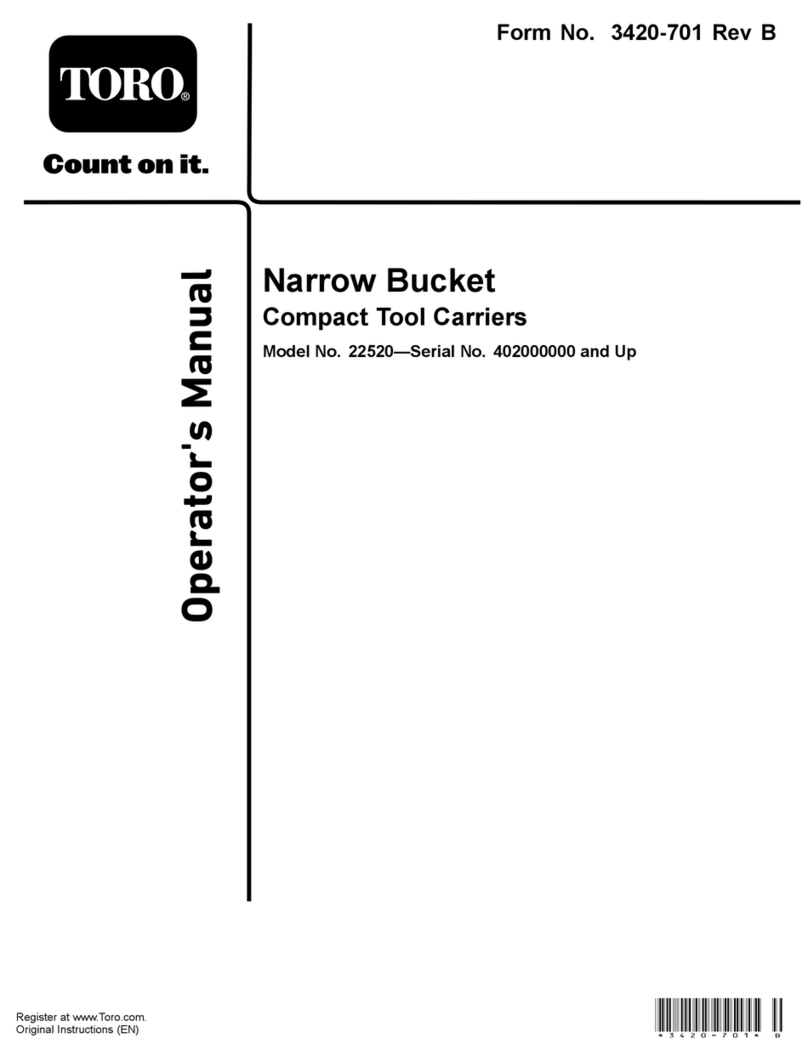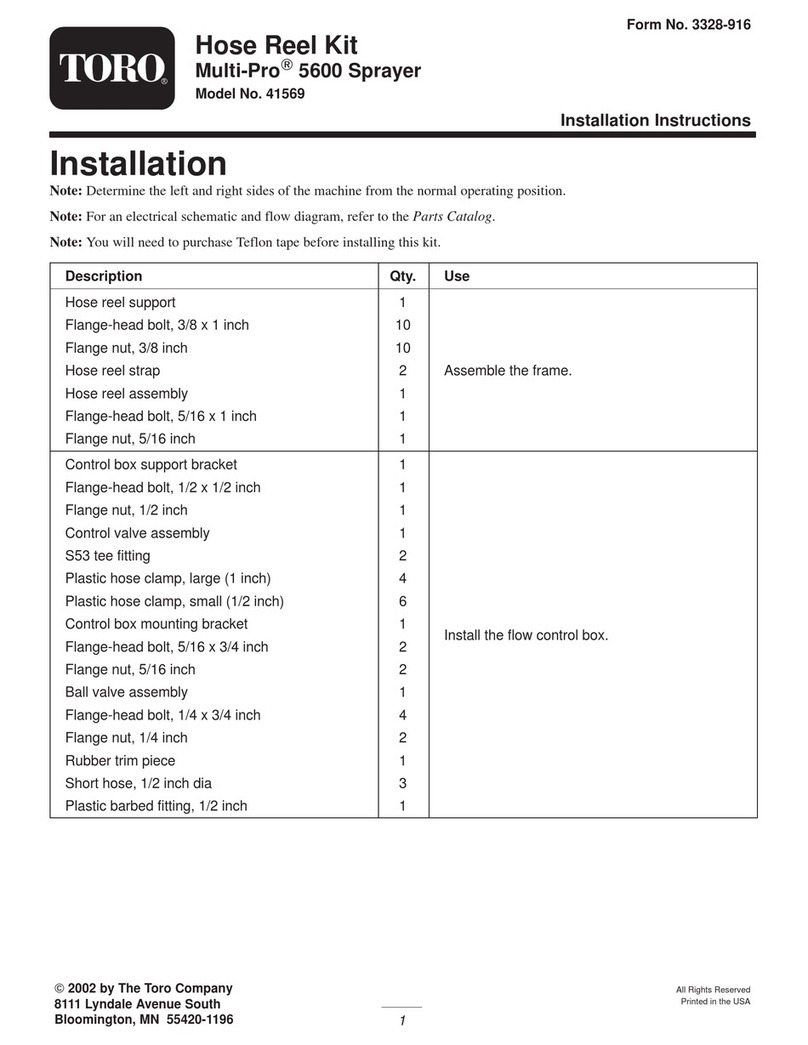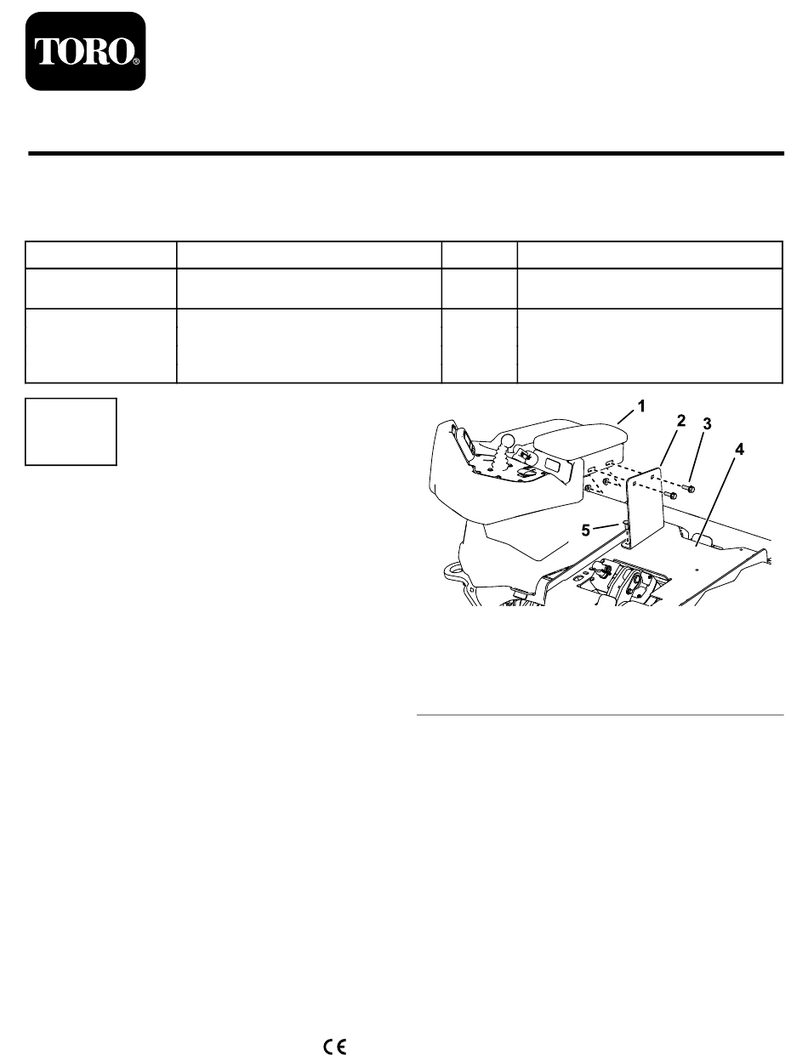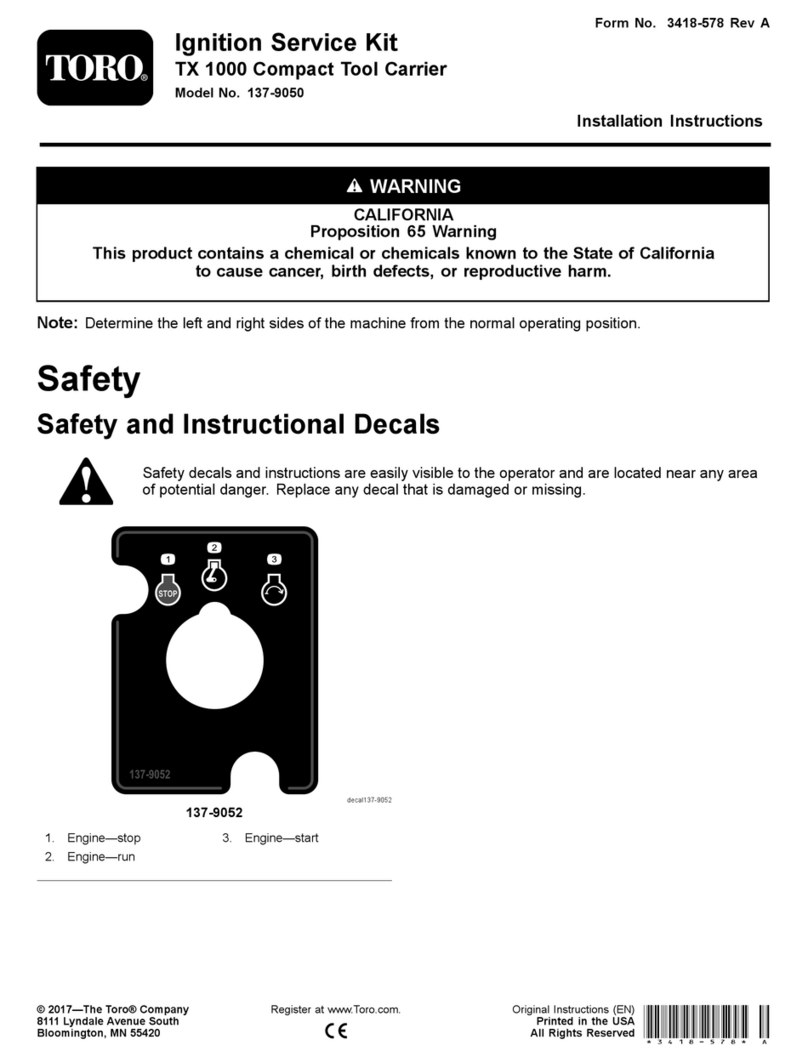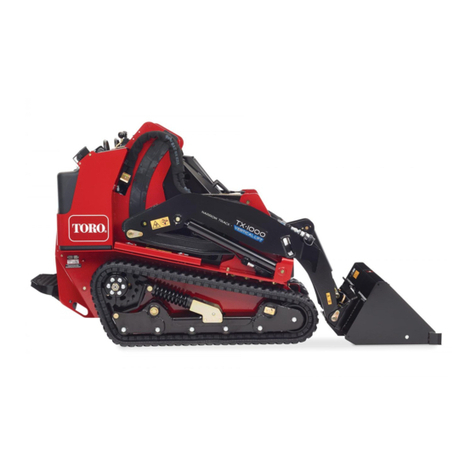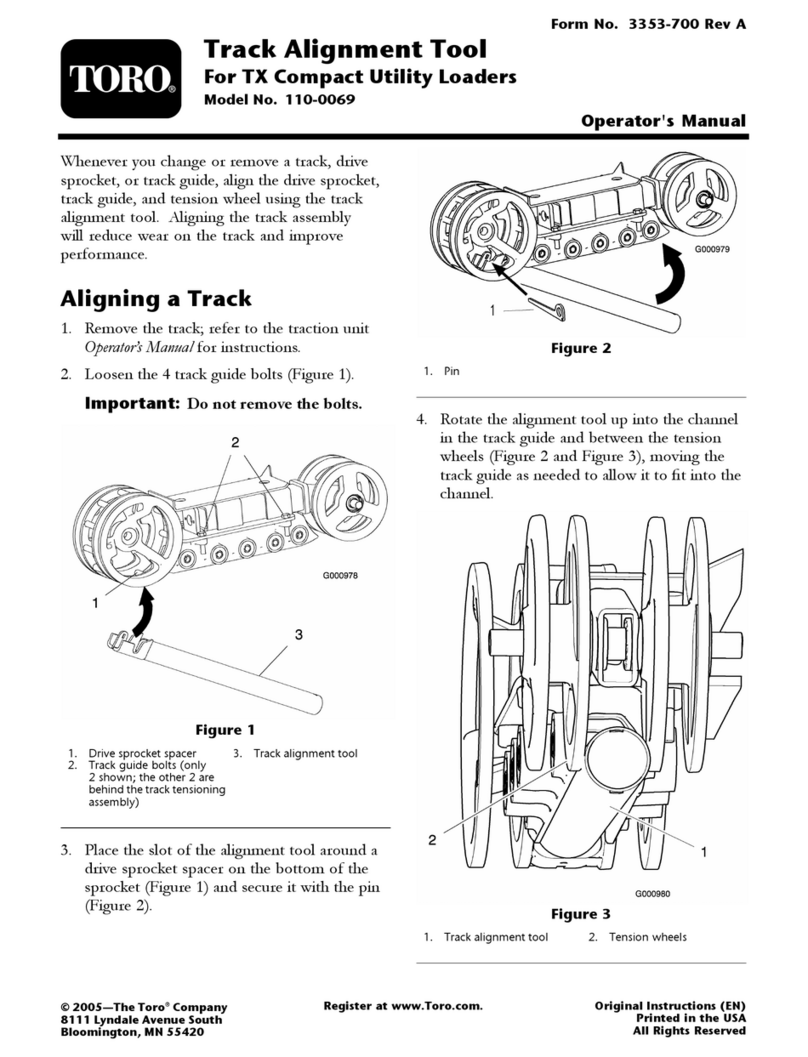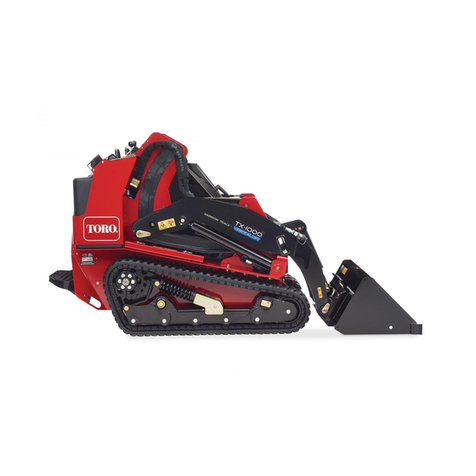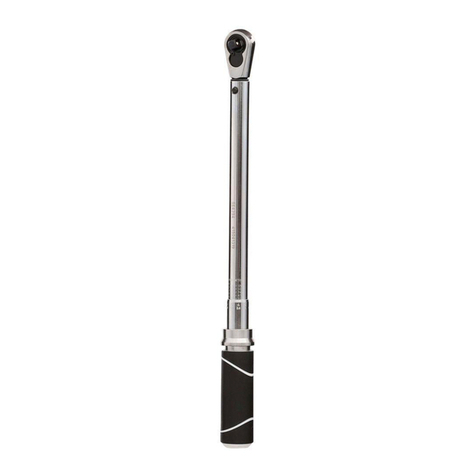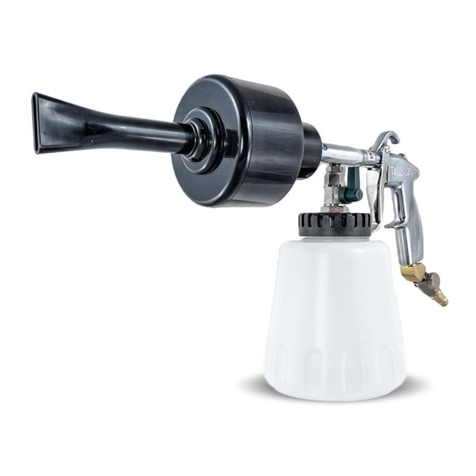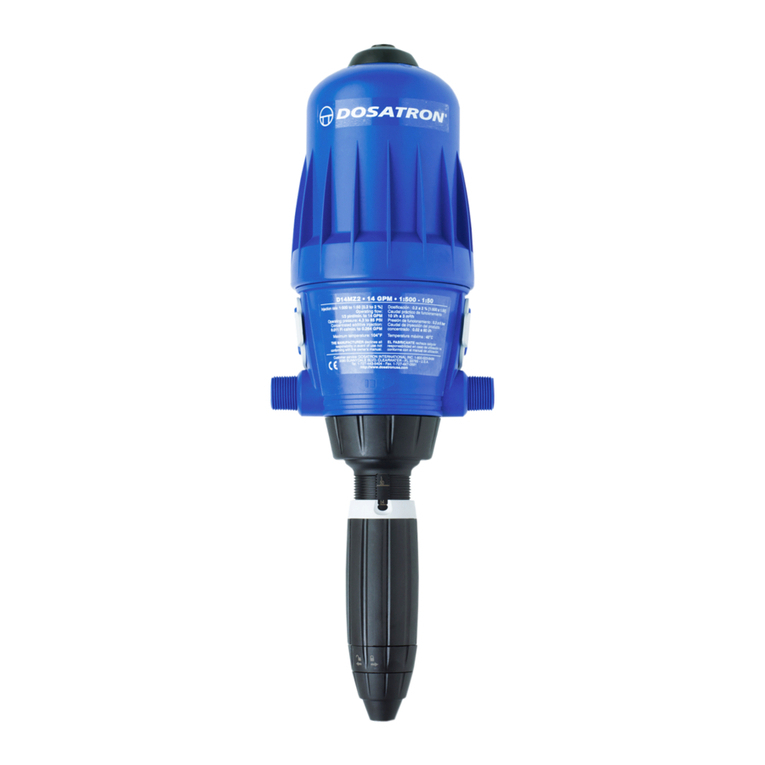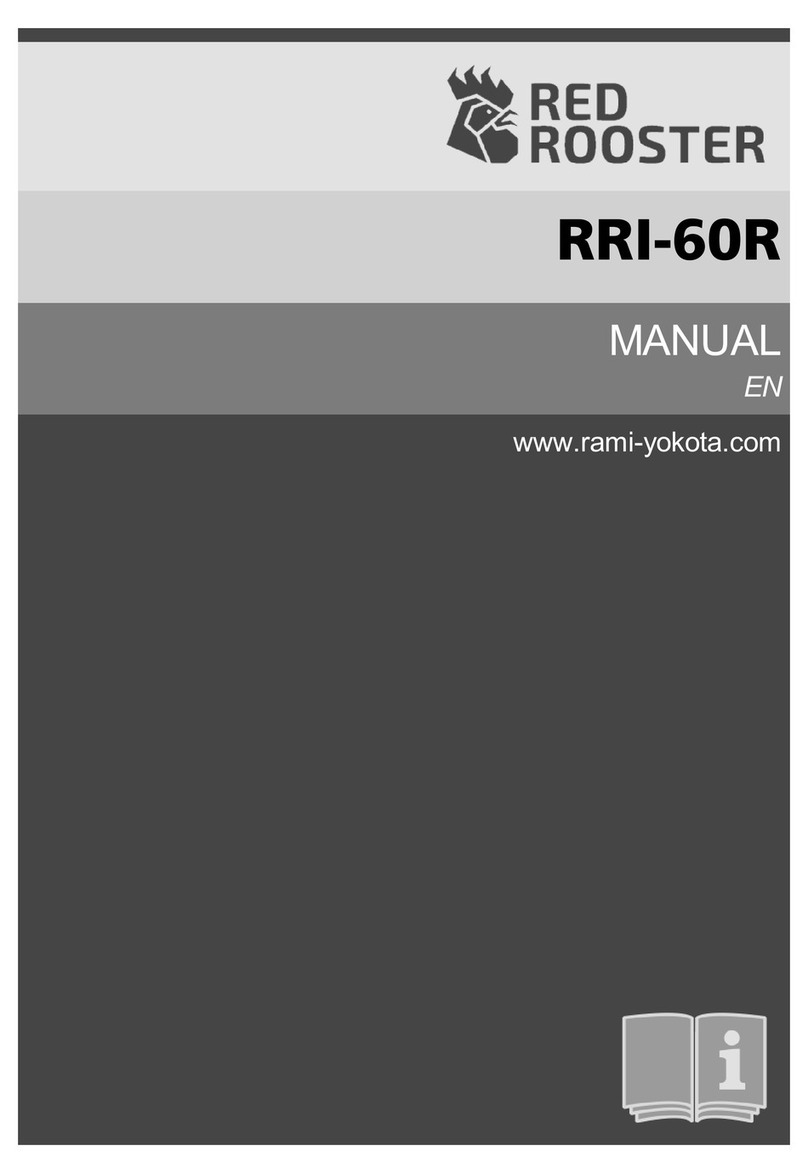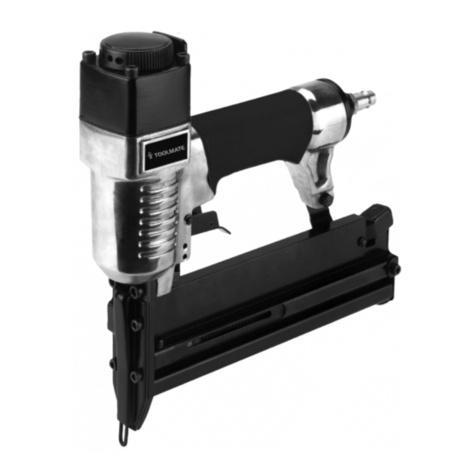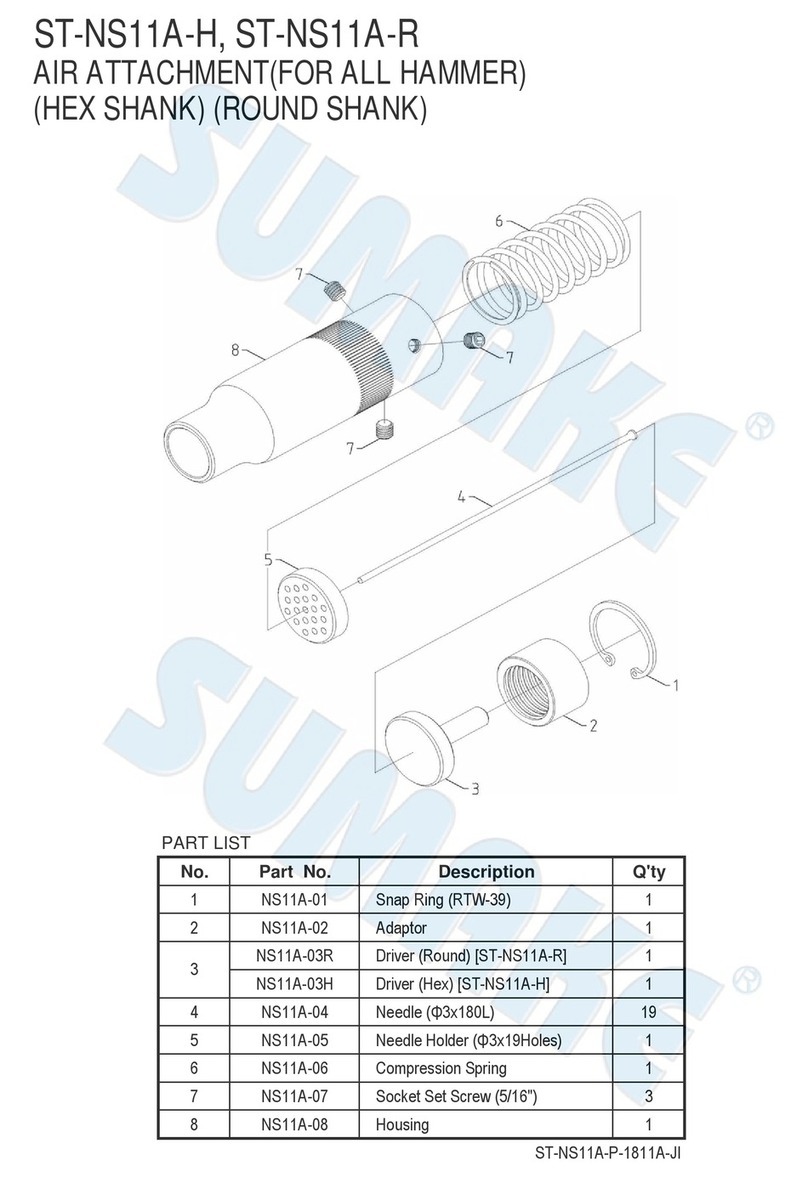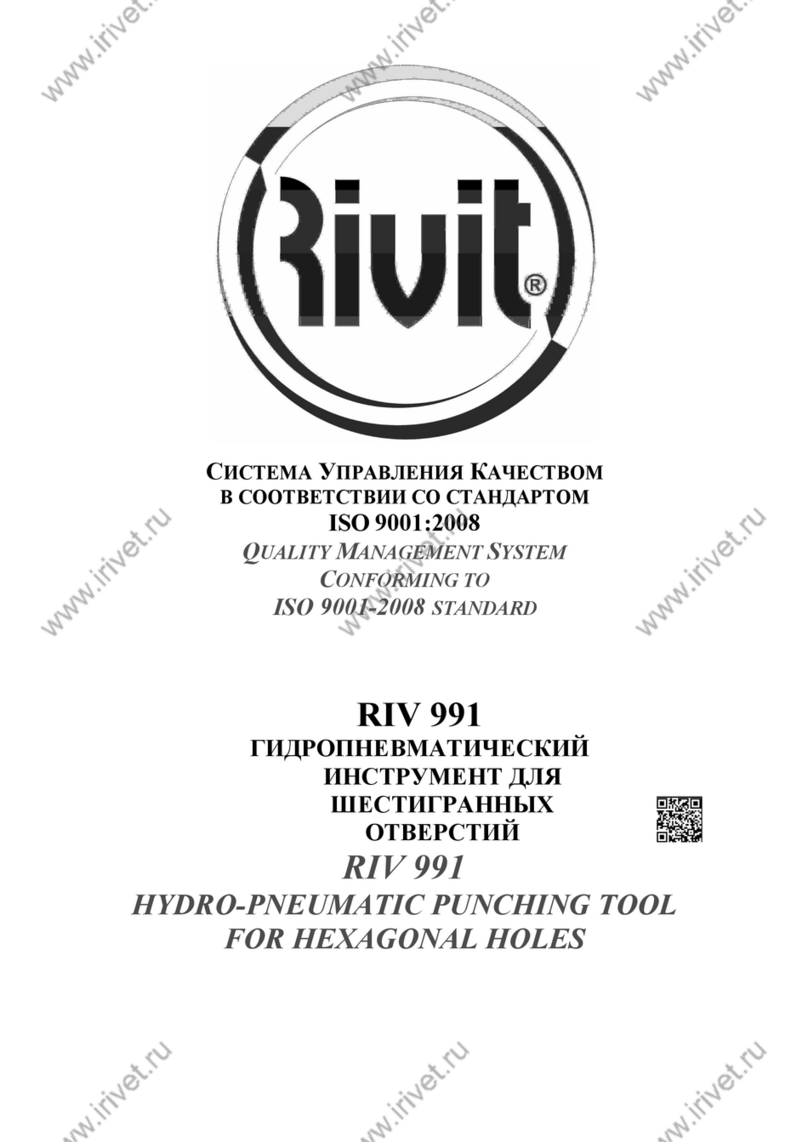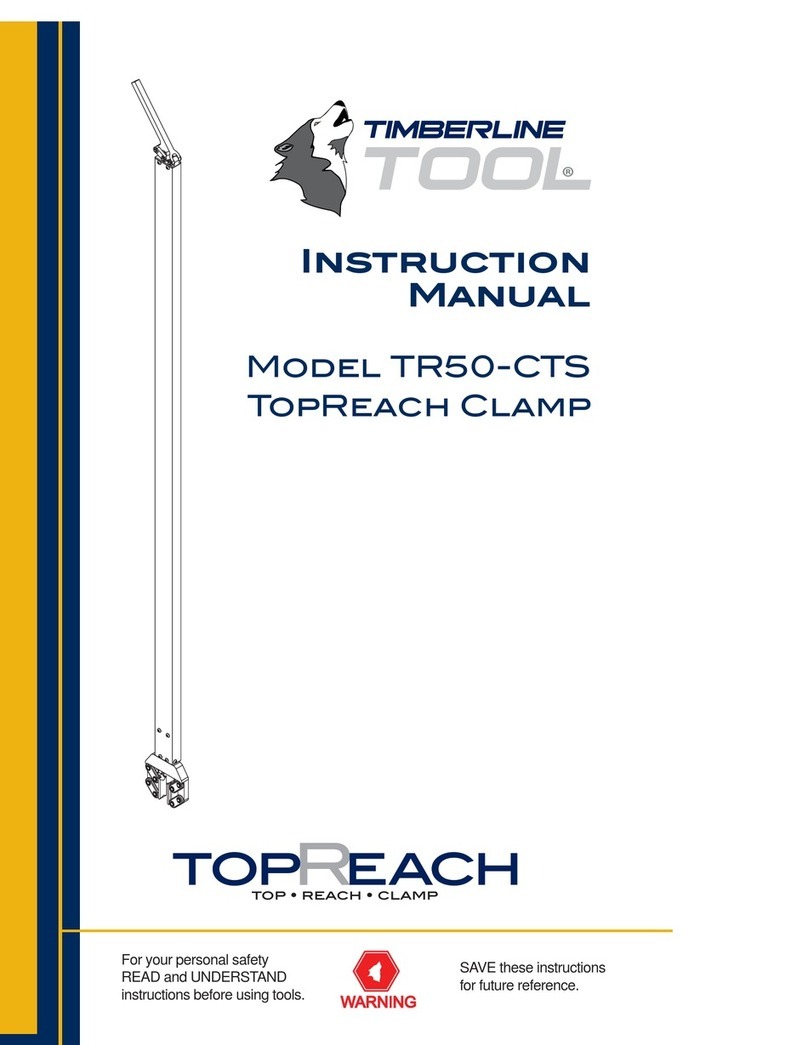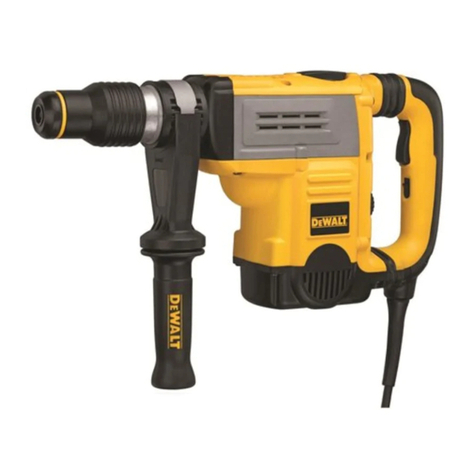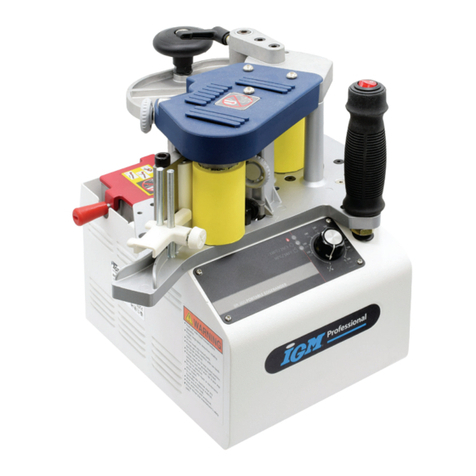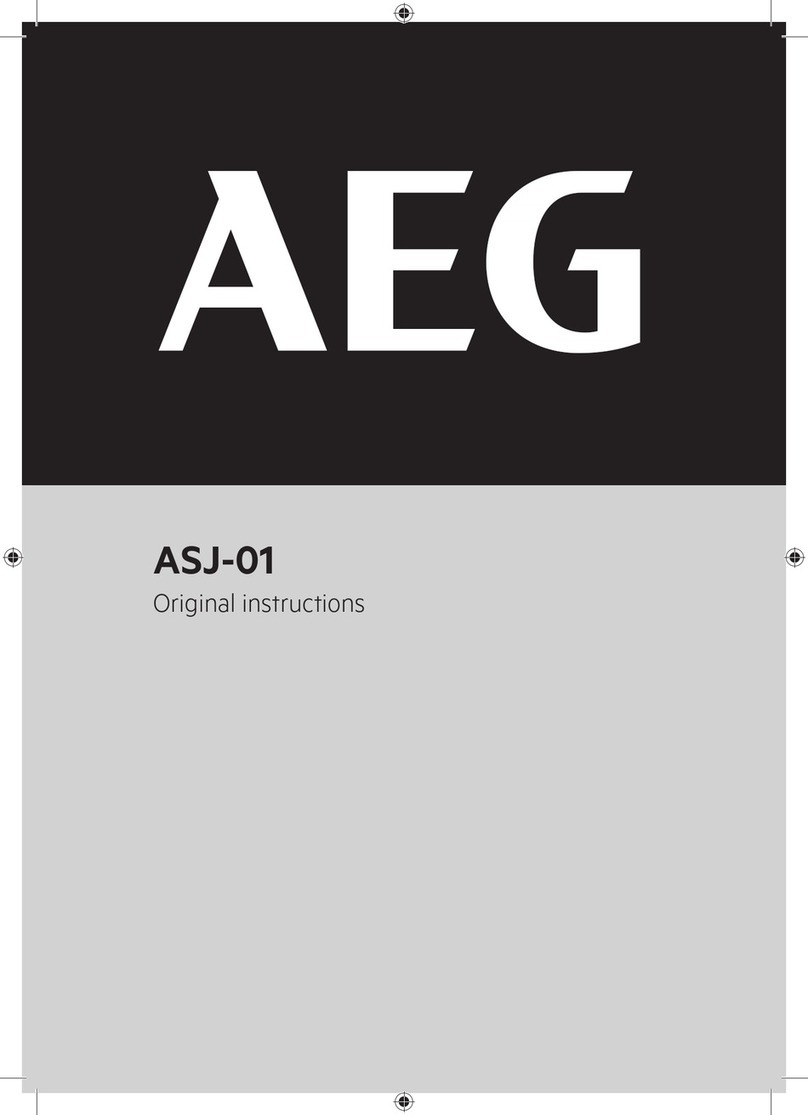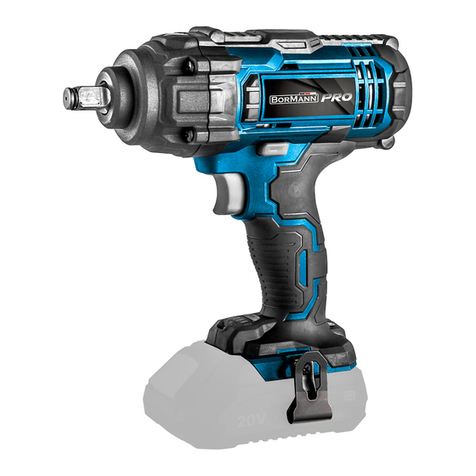Toro 5 User manual

Operator’s Manual
Domestic English (EN)
Form No. 3323-831 Rev A
5, 7 and 11 Blade Reels
for Reelmaster5500 & 6000 Series
03860—200000001 & Up
03861—200000001 & Up
03862—200000001 & Up

The Toro Company – 1999
Printed in USA All Rights Reserved
Introduction
Thank you for purchasing a Toro product.
All of us at Toro want you to be completely satisfied
with your new product, so feel free to contact your
local Authorized Service Dealer for help with service,
genuine Toro replacement parts, or other information
you may require.
Whenever you contact your Authorized Service
Dealer or the factory, always know the model and
serial numbers of your product. These numbers will
help the Service Dealer or Service Representative
provide exact information about your specific
product. You will find the model and serial number
plate located in a unique place on the product as
shown below.
1
1. Modeland Serial Number Plate
For your convenience, write the product model and
serial numbers in the space below.
Model No:
Serial No.
Read this manual carefully to learn how to operate
and maintain your product correctly. Reading this
manual will help you and others avoid personal injury
and damage to the product. Although Toro designs,
produces and markets safe, state-of-the-art products,
you are responsible for using the product properly
and safely. You are also responsible for training
persons who you allow to use the product about safe
operation.
The Toro warning system in this manual identifies
potential hazards and has special safety messages that
help you and others avoid personal injury, even death.
DANGER, WARNING and CAUTION are signal
words used to identify the level of hazard. However,
regardless of the hazard, be extremely careful.
DANGER signals an extreme hazard that will cause
serious injury or death if the recommended
precautions are not followed.
WARNING signals a hazard that may cause serious
injury or death if the recommended precautions are
not followed.
CAUTION signals a hazard that may cause minor or
moderate injury if the recommended precautions are
not followed.
Two other words are also used to highlight
information. “Important” calls attention to special
mechanical information and “Note” emphasizes
general information worthy of special attention.
The left and right side of the cutting unit is
determined by standing with the rear roller nearest
you.

1
Contents
Page
Safety 2. . . . . . . . . . . . . . . . . . . . . . . . . . . . . . . . .
Safe Operating Practices 2. . . . . . . . . . . . . .
Safety and Instruction Decals 3. . . . . . . . . . .
Specifications 4. . . . . . . . . . . . . . . . . . . . . . . . . . .
Set–Up 5. . . . . . . . . . . . . . . . . . . . . . . . . . . . . . . .
Loose Parts 5. . . . . . . . . . . . . . . . . . . . . . . . .
Inspection 5. . . . . . . . . . . . . . . . . . . . . . . . . .
Adjusting Front Shield 5. . . . . . . . . . . . . . . .
Adjusting Rear Shield 5. . . . . . . . . . . . . . . .
Adjusting Turf Compensation Spring 6. . . .
Setting Height-of-Cut 7. . . . . . . . . . . . . . . . . . . .
A. Adjusting (Parallel) Bedknife to Reel 7. .
B. Setting Cutting Unit Attitude 9. . . . . . . .
C. Leveling Front Roller 13. . . . . . . . . . . . . .
D. Finalizing Height-of-Cut 14. . . . . . . . . . . .
Page
Maintenance 15. . . . . . . . . . . . . . . . . . . . . . . . . . . .
Backlapping Reelmaster 5500
Traction Units 15. . . . . . . . . . . . . . . . . . . . .
Backlapping Reelmaster 6000
Traction Units 17. . . . . . . . . . . . . . . . . . . . .
Lubrication 19. . . . . . . . . . . . . . . . . . . . . . . . .
SPA (Single Point Adjustment) Spring
Adjustment 20. . . . . . . . . . . . . . . . . . . . . . .

2
Safety
Safe Operating Practices
•Read, understand, and follow all instructions in
the traction unit operator’s manual before
operating the cutting unit.
•Read, understand, and follow all instructions in
this operator’s manual before operating the
cutting unit.
•Never allow children to operate the cutting units.
Do not allow adults to operate traction unit or
cutting units without proper instruction. Only
trained operators who have read this manual
should operate the cutting units.
•Never operate the cutting units when under the
influence of drugs or alcohol.
•Keep all shields and safety devices in place. If a
shield, safety device or decal is illegible or
damaged, repair or replace it before operation is
commenced. Also tighten any loose nuts, bolts,
and screws to ensure cutting unit is in safe
operating condition.
•Always wear substantial shoes. Do not operate
cutting unit while wearing sandals, tennis shoes,
sneakers or shorts. Also, do not wear loose
fitting clothing which could get caught in
moving parts. Always wear long pants and
substantial shoes. Wearing safety glasses, safety
shoes and a helmet is advisable and required by
some local ordinances and insurance regulations.
•Remove all debris or other objects that might be
picked up and thrown by the cutting unit reel
blades. Keep all bystanders away from the
mowing area.
•If the cutting blades strike a solid object or the
cutting unit vibrates abnormally, stop and shut
the engine off. Check cutting unit for damaged
parts. Repair any damage before restarting and
operating the cutting unit.
•Lower the cutting units to the ground and
remove key from ignition switch whenever
machine is left unattended.
•Be sure cutting units are in safe operating
condition by keeping nuts, bolts and screws
tight.
•Remove key from ignition switch to prevent
accidental starting of the engine when servicing,
adjusting or storing the machine.
•Perform only those maintenance instructions
described in this manual. If major repairs are
ever needed or assistance is desired, contact an
Authorized Toro Distributor.
•To ensure optimum performance and safety,
always purchase genuine Toro replacement parts
and accessories to keep the Toro all TORO.
Never use “will-fit” replacement parts and
accessories made by other manufacturers.
Look for the Toro logo to assure genuineness.
Using unapproved replacement parts and
accessories could void the warranty of The Toro
Company.

Safety
3
Safety and Instruction Decals
Safety decals and instructions are easily visible to the operator and are located near
any area of potential danger. Replace any decal that is damaged or lost.
ON FRONT SHIELD OF CUTTING UNIT
(Part No. 93–6688)

4
Specifications
Reel Construction: Fairway reels. All welded. 5, 7
or 11 blades.
Recommended Height Of Cut Range:
5 Blade – 1” to 1-3/4” (25–44 mm)
7 Blade – 1/2” to 1” (13–25 mm)
11 Blade – 3/8” to 3/4” (10–19 mm)
Note: Use bedknife Part No. 93-9774 for
heights-of-cut below 1/2” (13 mm).
Reel Diameter: 7 in. (178 mm)
Power Attachment: Reel motors feature quick
disconnect for removal or installation onto cutting
unit. Cutting units can be driven from either end.
Height–of–cut & Roller Adjustment: Height-of-cut
adjustment is made at the rear roller with quick
locating pin and/or threaded micro–adjustment. Front
roller position is adjustable to set cutting unit attitude.
Bedknife And Bedbar Adjustment: Single point
adjustment (SPA) mechanism.
Selected Clip Control: The Reelmaster 5500
Traction Unit is equipped with manually adjustable
reel speeds which control selected clip.
Note: Refer to Traction Unit Operator’s
Manual for proper set–up procedure.
Automatic Clip Control: The Reelmaster 6000
Series Traction Unit is equipped with an electronic
controller which is programmed to achieve automatic
clip control. As the traction unit speed varies, the
controller will automatically adjust the hydraulic flow
to the reel motors to vary reel speed and maintain
proper clip. For proper clip, the controller needs to
know what cutting units are installed (5, 7 or 11
blade) and the height-of-cut.
Note: Refer to Traction Unit Operator’s
Manual for proper set–up procedure.
Rollers: Front roller is a 3” (76 mm) diameter cast
Wiehle roller. Rear roller is a 3” (76 mm) diameter
steel full roller. Both rollers use heavy duty ball
bearings with two conventional single lip seals and a
Toro labyrinth seal to provide four sealing surfaces to
protect the bearings.
Optional Equipment
Dethatching Cutting Unit Model No. 03871
Grass Basket Kit Model No. 03882
High Torque Reel Motor Part No. 98-2448
Wiehle Roller Scraper Part No. 100-9908
Rear Roller Scraper Kit Part No. 100-9920
RM6000 Shoulder Wiehle Roller Part No. 99-8675
RM5500 Shoulder Wiehle Roller Part No. 100-9911
RM6000 Shoulder Wiehle Scraper Part No. 99-8670
RM5500 Shoulder Wiehle Scraper Part No. 100-9913
Low Height-of-Cut Bedknife*Part No. 93-9774
Gauge Bar AssemblyPart No. 98-1852
Angle Indicator Part No. 99-3503
Backlapping Brush Assembly Part No. TOR299100
Bedknife Screw Tool Part No. TOR510880
Cutting Unit Tool Kit Part No. TOR4070
Reel Drive Tool Part No. TOR4074
* For height-of-cut below 1/2” (13 mm)
Supplied with tractor

5
Set–Up
Loose Parts
Note: Use the chart below to verify all parts have been shipped.
DESCRIPTION QTY. USE
Operator’s Manual 1Read before operating machine.
Parts Catalog 1Use for ordering replacement parts.
Registration Card 1Fill out and return to Toro.
Inspection
After the cutting unit is unboxed, inspect the
following:
1. Check each end of the reel for grease. Grease
should be visibly evident in the reel bearings and
internal splines of reel shaft.
2. Ensure that all nuts and bolts are securely
fastened.
3. Make sure carrier frame suspension operates
freely and does not bind when moved back and
forth.
Adjusting Front Shield
Adjust front shield for desired grass clippings
dispersion.
1. Position cutting unit on a flat level surface.
2. Loosen flange head capscrew securing shield to
right side plate. Move shield to desired angle and
tighten screw (Fig. 1).
1
2
3
4
Figure 1
1. Front grass shield
2. Front capscrew 3. Rear grass shield
4. Rear capscrew
Adjusting Rear Shield
Under most conditions, best dispersion is attained
when rear shield is closed (front discharge). When
conditions are heavy or wet, rear shield may be
opened.
1. To open rear shield (Fig. 1), loosen flange head
capscrew securing shield to right side plate,
rotate shield to open position and tighten
capscrew.

Set–Up
6
Adjusting Turf Compensation
Spring
The Turf Compensation Spring (Fig. 2), connecting
carrier frame to cutting unit, controls the amount of
fore-aft rotation available, as well as the amount of
ground clearance in transport and turn around.
The Turf Compensation Spring also transfers weight
from the front to rear roller. This helps to reduce a
wave pattern in the turf, also known as bobbing.
IMPORTANT: Make spring adjustments with
cutting unit mounted to traction unit and
lowered to shop floor. Refer to Traction Unit
Operator’s Manual for mounting
instructions.
1. Tighten lock nut on rear of spring rod until the
gap (C) between rear of spring bracket and front
of washer is 1” (26 mm) (Fig. 2).
2. Tighten hex nuts on front end of spring rod until
the compressed length (A) of spring is 8” (203
mm) (Fig. 2).
Note: When cutting rough or undulating turf,
increase compressed length (A) of
spring to 8-1/2” (216 mm) and gap (C)
between rear of spring bracket and
front of washer to 1-1/2” (39 mm)
(Fig. 2).
Note: As compressed spring length (A)
decreases, weight transfer from front
roller to rear roller increases and
carrier frame/cutting unit rotation angle
(B) decreases.
Note: As gap (C) between spring bracket and
washer increases, cutting unit ground
clearance decreases and carrier
frame/cutting unit rotation angle (B)
increases.
“C”
“A”
“B”
Figure 2

7
Setting Height-of-Cut
IMPORTANT: To insure proper setting of
height-of-cut, these procedures must be
followed in this order:
A. Adjusting (Parallel) Bedknife To Reel
B. Setting Cutting Unit Attitude
C. Leveling Front Roller
D. Finalizing Height-of-Cut
IMPORTANT: Each cutting unit must be set
consistently. Minor differences in
either height-of-cut, attitude, bedknife wear,
or reel blade wear, among cutting units, may
result in negative after cut appearance.
Note: The cutting unit has been set at the
factory at 5/8” (16 mm) height-of-cut
and with a cutting unit attitude of 2
degrees. Also, the bedknife has been
backed off from the reel to prevent
shipping damage. Verify setting to
ensure changes did not occur during
shipment.
A. Adjusting (Parallel) Bedknife
to Reel
IMPORTANT: The reel and bedknife must be
parallel to insure the cutting unit cuts grass
across the bedknife, and the reel and bedknife
wear evenly.
Note: Toro recommends light contact
between the reel and bedknife.
However, for dry and/or sparse
conditions a .001–.002” (.03–.05 mm)
clearance may be required to prevent
heat buildup which can cause uneven
wear in the reel and bedknife.
Note: A 3/4 inch (19 mm) wrench is needed
to rotate bedknife adjustment knob.
Each notch on the knob will move the
bedknife 0.0005 inches (.013 mm)
closer to the reel (Fig. 3).
1
Figure 3
1. Bedknifeadjusting knob
1. Rotate cutting unit backward to gain access to
reel and bedknife (Fig. 4).
2. While slowly rotating the reel in the mowing
direction, turn the bedknife adjusting knob
clockwise until you hear light contact between
the reel and bedknife.
3. Insert a 1” (25 mm) wide piece of newspaper
perpendicular to the bedknife, and then rotate the
reel slowly in the mowing direction to see if the
reel cuts the paper - do this on both ends of the
bedknife (Fig. 4).

Setting Height-of-Cut
8
RIGHT
LEFT
Figure 4
4. If paper is cut on both ends, the bedknife is
parallel to the reel. If not proceed to step 5.
Note: If reel makes contact on both sides of
bedknife but still does not cut paper,
cutting unit may need to be backlapped
(refer to Backlapping) and/or reel and
bedknife may need to be reground
(refer to Toro manual for Sharpening
Reel and Rotary Mowers, Form No.
80–300PT).
1
2
3
4
Figure 5
1. Pivot hub casting
2. Pivot hub locknuts 3. Top adjusting nut
4. Bottom adjusting nut
5. Loosen the pivot hub lock nuts to allow
movement of the pivot hub casting (Fig. 5).
6. If paper was not cut on the left side: loosen the
bottom adjusting nut on the pivot hub, then turn
the top adjusting nut clockwise to pull the pivot
hub up. OR If paper was not cut on the right
side: loosen the top adjusting nut on the pivot
hub, then turn the bottom adjusting nut
counterclockwise to push the pivot hub down
(Fig. 5).
Note: To reduce thread play, always tighten
the bottom adjusting nut last.
7. Recheck reel to bedknife contact on both ends of
the bedknife, and repeat step 6 as necessary.
Note: Reel to bedknife contact may become
too tight or too loose after previous
adjustment; therefore, turn bedknife
adjustment knob, accordingly, for light
contact.
8. Retighten pivot hub lock nuts.
Note: Recheck if paper cuts on both ends, to
insure the bedknife did not move when
re–tightening the pivot hub lock nuts.

Setting Height-of-Cut
9
B. Setting Cutting Unit Attitude
IMPORTANT: Cutting unit “attitude” has a
significant impact on the performance of the
cutting unit. Attitude refers to the angle of the
bedknife relative to the ground (Fig. 6).
Adjustable front and rear brackets allow for
variable adjustment of cutting unit attitude
within the height-of-cut range. All cutting
units on a given machine must be set to the
same attitude, otherwise after-cut appearance
could be negatively affected.
ATTITUDE
Figure 6
The best cutting unit attitude is dependent on your
turf conditions and desired results. Experience with
the cutting unit on your turf will determine the best
setting to use. Cutting unit attitude can be adjusted
throughout the cutting season to allow for various turf
conditions.
In general, less aggressive attitudes (example: 2
degrees) are more appropriate for warm season
grasses (Bermuda, Zoysia) while cool season grasses
(Bluegrass, Rye) may require more aggressive
attitudes (example: 6 degrees). More aggressive
attitudes cut more grass off by allowing the spinning
reel to pull more grass up into the bedknife. An angle
that is too flat (attitude less than 1 degree) may allow
the bedbar or other parts of the cutting unit to drag in
the turf causing tufting. Therefore, minimum
recommended attitude is 1 degree.
For setting consistent cutting unit attitude, Toro
strongly recommends using a two-screw gauge bar,
Toro part no. 98-1852 (Fig. 7). The first screw is set
for height-of-cut, and the second screw is set for
cutting unit attitude. The second screw setting is an
easy method of transferring cutting unit attitude to all
cutting units on a machine.
HOC SETTING
ATTITUDE 2.00”
(51 mm)
“A”
First Screw
Second Screw
Figure 7
Setting Attitude for New Cutting Units
Table 1 lists starting dimensions for setting up a new
cutting unit with attitudes of 2, 4, 6 and 8 degrees.
Note: The second screw setting will change
throughout the life of the bedknife and
reel due to wear, even if the
height-of-cut is not changed.
Therefore, after initial set up use
Checking and Adjusting Attitude for
Used Cutting Unit procedure.
1. Using a two-screw gauge bar, Toro Part No.
98-1852, set first screw to desired height-of-cut.
This setting is from the bar face to the underside
of the screw head (Fig. 7).
2. Using Table 1, set the attitude, “A,” for the
second screw on the gauge bar. This setting is
from the bar face to the end of the screw (Fig. 7).

Setting Height-of-Cut
10
Table 1—New Cutting Unit Set Up Guide
Desired Height-of-Cut
(HOC) Desired
Attitude Second Screw “A”
(Fig. 7) Front Height-of-Cut
Rod “B” (Fig. 8) Rear Height-of-Cut
Rod “C” (Fig. 8) Rear Support
Bracket (Fig. 8)
(in) (mm) (degrees) (in) (mm) (in) (mm) (in) (mm) (location)
0.375 (10) 2* 0.180 4.6 1.625 41.3 1.866 47.4 top
4* 0.231 5.9 1.825 46.4 1.625 41.3 top
6* – – 2.026 54.5 1.387 35.2 top
8* – ––––– top
0.500 (13) 2* 0.299 7.6 1.499 38.1 1.740 44.2 top
4* 0.356 9.0 1.700 43.2 1.500 38.1 top
6* 0.414 10.5 1.901 48.3 1.262 32.1 top
8* – ––––– top
2 0.228 5.8 1.360 34.5 1.910 48.5 top
4 0.285 7.2 1.561 39.6 1.668 42.4 top
6 0.342 8.7 1.762 39.6 1.429 26.3 top
8 – – 1.963 49.9 1.191 30.3 top
0.625 (16) 2 0.353 9.0 1.234 31.3 1.784 45.3 top
4 0.410 10.4 1.435 36.4 1.543 29.2 top
6 0.467 11.9 1.636 41.6 1.304 24.6 top
8 – – 1.838 46.7 1.066 27.1 top
0.750 (19) 2 0.478 12.1 1.109 28.2 1.659 42.1 top
4 0.535 13.6 1.310 33.3 1.418 36.0 top
6 0.592 15.0 1.511 38.4 1.179 29.9 top
8 0.650 16.5 1.713 43.5 0.94123.9 top
0.875 (22) 2 0.603 15.3 0.98325.0 1.533 38.9 top
4 0.660 16.8 1.185 30.1 1.292 45.5 top
6 0.717 18.2 1.386 35.2 1.054 26.8 top
8 0.775 19.7 1.588 40.3 0.81620.7 top
1.000 (25) 2 0.728 18.5 0.85721.8 1.407 35.7 top
4 0.785 19.9 1.060 26.9 1.167 29.6 top
6 0.842 21.4 1.261 32.0 0.92923.6 top
8 0.900 22.9 1.463 37.2 0.69117.6 top
1.125 (29) 2 0.853 21.7 0.73218.6 1.282 32.6 top
4 0.910 23.1 0.93423.7 1.042 26.5 top
6 0.967 24.6 1.136 28.9 0.80420.4 top
8 1.025 26.0 1.388 35.3 0.56614.4 top
1.250 (32) 2 0.978 24.8 0.60615.4 1.156 29.4 top
4 1.035 26.3 0.80920.5 0.91623.3 top
6 1.092 27.7 1.011 25.7 0.67917.2 top
8 1.150 29.2 1.213 30.8 0.44111.2 top
1.375 (35) 2 1.103 28.0 0.48012.2 1.030 26.2 top
4 1.160 29.5 0.68417.4 0.79120.1 top
6 1.217 30.9 0.88622.5 0.55314.0 top
8 1.275 32.4 1.088 27.6 0.3168.0 top
1.500 (38) 2 1.228 31.2 0.3559.0 0.90523.0 top
4 1.285 32.6 0.55814.2 0.66616.9 top
6 1.342 34.1 0.76119.3 0.42810.9 top
8 1.400 35.6 0.96324.5 0.1914.9 top
1.625 (41) 2 – – 0.2295.8 1.404 35.7 bottom
4 1.410 35.8 0.43311.0 1.166 29.6 bottom
6 1.427 36.2 0.63616.2 0.92823.6 bottom
8 1.525 38.7 0.83821.3 0.69117.6 bottom
1.750 (45) 2 – – 0.1032.6 1.278 32.5 bottom
4 1.535 39.0 0.3087.8 1.040 26.4 bottom
6 1.592 40.4 0.51113.0 0.80320.4 bottom
8 1.650 41.9 0.71318.1 0.56614.4 bottom
* Optional Low Cut Bedknife, Toro part no. 93-9774, is required for height-of-cut below 0.500” (13 mm).
For front (”B”) or rear roller distances (“C”) less than 1” (25 mm) order long cone nut (Part No. 95-2790) to
replace bottom cone nut for improved support.

Setting Height-of-Cut
11
3. Rotate the cutting unit backward to gain access
to reel and bedknife.
4. Set the front height-of-cut rod height,“B,” using
the dimension given in Table 1. This
measurement is between the top surface of the
height-of-cut rod and top cone nut (Fig. 8).
5. Set the rear support casting in either the top or
bottom location as indicated in Table 1. Set the
rear height-of-cut rod height .100” (3 mm) less
than the dimension given in Table 1 which will
create a gap between the rear roller and the
gauge bar (Fig. 8).
1
2
“B”
3
4
“C”
3
4
Figure 8
1. First screw
2. Second screw 3. Height-of-cut rod
4. Cone nut
6. Place gauge bar across front and rear rollers. The
first screw head should fit snugly over edge of
bedknife and the end of second screw should
contact bottom of bedknife (Fig. 8). If there is a
gap between the front roller and the gauge bar or
you can not put the gauge bar on, adjust the front
roller until: (1) first (height-of-cut) screw fits
snugly over bedknife, (2) second screw just
contacts bedknife, and (3) gauge bar touches
front roller. Verify front roller (attitude) at each
end of the bedknife.
Note: At this time, there should be a small
gap between the rear roller and gauge
bar.

Setting Height-of-Cut
12
Checking or Adjusting Attitude for Used
Cutting Units
Note: As a starting point for adjusting cutting
unit attitude, the cutting unit may be
set up using the dimensions from
Table 1. However, because of wear on
the bedknife and reel, the following
procedure must be used to ensure the
correct attitude setting.
1. Rotate cutting unit backward to gain access to
reel and bedknife.
2. Place an angle indicator, Toro Part No. 99–3503,
on the bedknife and record the bedknife angle
(Fig. 9).
1
Figure 9
1. Bedknifeangle
3. Using a two-screw gauge bar, Toro Part No.
98-1852, set first screw to desired height-of-cut.
4. Place the gauge bar across front and rear rollers.
The first screw head needs to fit snugly over
edge of the bedknife,while the gauge bar
contacts the front roller (Fig. 10).
Note: The rear roller does not have to contact
the gauge bar.
5. Adjust second screw to contact bedknife. Move
rear roller up, if needed.
6. Place an angle indicator on the gauge bar and
record the gauge bar angle (Fig. 10).
1
2
34
increase
attitude
decrease
attitude
Figure 10
1. First screw
2. Second screw 3. Gauge bar angle
4. Front Roller

Setting Height-of-Cut
13
7. Adjust the front roller to your desired cutting
unit attitude:
Bedknife Angle (step 2)
– Gauge Bar Angle (step 6)
= Cutting Unit Attitude (degrees)
Note: Moving the front roller down will
decrease your cutting unit attitude,
while moving the front roller up will
increase cutting unit attitude (Fig. 10).
C. Leveling Front Roller
IMPORTANT: Toro strongly recommends the
use of a leveling plate when setting–up or
adjusting any reel type cutting unit. The
leveling plate will help to ensure accurate and
consistent adjustments. Contact your local
Toro Distributor for ordering a leveling plate.
1. Position cutting unit on a flat surface.
2. Position a 1” (25 mm) or thicker bar (for higher
heights-of-cut) under the reel blades and against
the front edge of the bedknife (Fig. 11). Make
sure bar covers the full length of the reel
blades.
3. Rock cutting unit forward (on reel blades and
steel bar) until front roller contacts flat surface.
Reel blades and bedknife must maintain contact
with bar. Rear roller should not contact surface
(Fig. 11).
Contact along full length of front roller and reel blade
levels front roller to reel.
Bar stock (1” x 3/4”
stock suggested)
Ref. flat surface
(1” x 20 x 30” flat
stock suggested)
Figure 11
4. Use a piece of newspaper or visually check to
see if any gap exists between front roller ends
and flat surface (Fig. 12). If needed, adjust
front height-of-cut rods until both ends of
roller are in contact with level surface.

Setting Height-of-Cut
14
Note: If leveling the front roller causes the
cutting unit attitude to be different
from side to side by more than one
degree, you may need to regrind the
reel and/or bedknife to eliminate
uneven wear.
Figure 12
D. Finalizing Height-of-Cut
1. Rotate the cutting unit vertical and place the
gauge bar across front and rear rollers (Fig. 13).
2. Adjust rear roller until it contacts the gauge bar
on both sides (Fig. 13).
1
2
3
Figure 13
1. First screw
2. Second screw 3. Adjust rear roller
Note: Make sure gauge bar is in contact with
the front roller at all times to keep
desired height-of-cut.
3. Slide gauge bar toward the end of the cutting
unit to remove. Gauge bar can now be utilized to
set remaining cutting units on machine.

15
Maintenance
Backlapping Reelmaster 5500
Traction Units
POTENTIAL HAZARD
•Reels may stall when backlapping.
WHAT CAN HAPPEN
•Reels may restart. Contact with rotating
reels will cause serious injury.
HOW TO AVOID THE HAZARD
•Do not attempt to restart reels by hand or
touch reels while backlapping.
•Stop engine and turn height-of-cut knob
one position toward “1.”
Note: When backlapping, the front units
all operate together, and the rear
units operate together.
1. Position the machine on a level surface, lower
the cutting units, stop the engine, engage the
parking brake, and move the Enable/Disable
switch to disable position.
2. Unlock and raise the seat to expose controls.
3. Locate the reel speed selector knobs and backlap
knobs (Fig. 14). Rotate the desired backlap
knob(s) to the backlap position and the desired
reel speed selector knob(s) to position “1.”
1
12
2
Figure 14
1. Reel speed selector knob 2. Backlap knob
Note: Backlapping speed may be increased
by moving the reel speed selector knob
toward “13”. Each position will
increase speed approximately 100 rpm.
After changing selector, wait 30
seconds for the system to stabilize at
the new speed.
4. Make initial reel to bedknife adjustments
appropriate for backlapping on all cutting units
which are to be backlapped.
5. Start engine and run at idle speed.

Maintenance
16
POTENTIAL HAZARD
•Changing engine speed while backlapping
may cause reels to stall.
WHAT CAN HAPPEN
•Reels may restart. Contact with rotating
reels will cause serious injury.
HOW TO AVOID THE HAZARD
•Never place hands or feet in reel area while
engine is running.
•Never change engine speed while
backlapping.
•Only backlap at idle engine speed.
•Never attempt to turn reels by hand or foot
while engine is running.
6. Select either front, rear, or both backlap knobs to
determine which reels will be backlapped.
7. Move Enable/Disable switch to Enable position.
Move Lower Mow/Lift control forward to start
backlapping operation on designated reels.
8. Apply lapping compound with a long handle
brush (Toro Part No. 29–9100). Never use a
short handled brush (Fig. 15).
1
Figure 15
1. Longhandle brush
9. If reels stall or become erratic while
backlapping, stop backlapping by moving the
Lower Mow/Lift control lever rearward. Once
the reels have stopped, move the desired reel
speed selector knob(s) one position closer to
“13.” Resume backlapping by moving the
Lower Mow/Lift control lever forward.
10. To make an adjustment to the cutting units while
backlapping, turn reels OFF by moving the
Lower Mow/Raise lever rearward; move the
Enable/Disable switch to Disable and turn the
engine OFF. After adjustments have been
completed, repeat steps 5–9.
11. Backlap until the reels can cut paper.
Note: When the cutting unit is adequately
sharpened, a burr will form on the
front edge of the knife. Using a file,
carefully remove the burr without
dulling the cutting edge (Fig. 16).
Figure 16
12. Repeat procedure for all cutting units to be
backlapped.
13. When backlap operation has been completed,
return the backlap knobs to the forward flow
position, lower seat and wash all lapping
compound off cutting units. Adjust cutting unit
reel to bedknife as needed.
IMPORTANT: If the backlap knobs are not
returned to the forward flow position after
backlapping, the cutting units will not raise
or function properly.

Maintenance
17
Backlapping Reelmaster 6000
Traction Units
POTENTIAL HAZARD
•Reels may stall when backlapping.
WHAT CAN HAPPEN
•Reels may restart. Contact with rotating
reels will cause serious injury.
HOW TO AVOID THE HAZARD
•Do not attempt to restart reels by hand or
touch reels while backlapping.
•Stop engine and turn height-of-cut knob
one position toward “A.”
Note: When backlapping, the front units
all operate together, and the rear
units operate together.
1. Position the machine on a level surface, lower
the cutting units, stop the engine, engage the
parking brake, and move the Enable/Disable
switch to disable position.
2. Unlock and raise the seat to expose controls.
3. Open control cover and turn the H.O.C. selection
knob to position “P” (Fig. 17).
1
Figure 17
1. Height-of-cutselection
knob
Note: Backlapping speed may be increased
by moving the H.O.C. selection knob
toward “A”. Each position will
increase speed approximately 60 rpm.
After changing selector, wait 30
seconds for the system to respond to
the new speed target.
4. Make initial reel to bedknife adjustments
appropriate for backlapping on all cutting units
which are to be backlapped.
5. Start engine and run at idle speed.

Maintenance
18
POTENTIAL HAZARD
•Changing engine speed while backlapping
may cause reels to stall.
WHAT CAN HAPPEN
•Reels may restart. Contact with rotating
reels will cause serious injury.
HOW TO AVOID THE HAZARD
•Never place hands or feet in reel area while
engine is running.
•Never change engine speed while
backlapping.
•Only backlap at idle engine speed.
•Never attempt to turn reels by hand or foot
while engine is running.
6. Select either front or rear on the backlap switch
to determine whether front or rear reels will be
backlapped.
7. Move Enable/Disable switch to Enable position.
Move Lower Mow/Lift control forward to start
backlapping operation on designated reels.
8. Apply lapping compound with a long handle
brush (Toro Part No. 29–9100). Never use a
short handled brush (Fig. 18).
1
Figure 18
1. Longhandle brush
9. If reels stall or become erratic while
backlapping, the reel control light will begin to
blink and the reels will turn off. If this occurs,
turn the H.O.C. selection knob one position
closer to “A”. Then, toggle the Enable/Disable
switch to the disable position followed by the
enable position. To resume backlapping, move
the Lower Mow/Lift control lever forward.
10. To make an adjustment to the cutting units while
backlapping, turn reels OFF by moving the
Lower Mow/Raise lever rearward; move the
Enable/Disable switch to Disable and turn the
engine OFF. After adjustments have been
completed, repeat steps 5–9.
11. Backlap until the reels can cut paper.
Note: When the cutting unit is adequately
sharpened, a burr will form on the
front edge of the knife. Using a file,
carefully remove the burr without
dulling the cutting edge (Fig. 19).
Figure 19
12. Repeat procedure for all cutting units to be
backlapped.
This manual suits for next models
2
Table of contents
Other Toro Tools manuals

